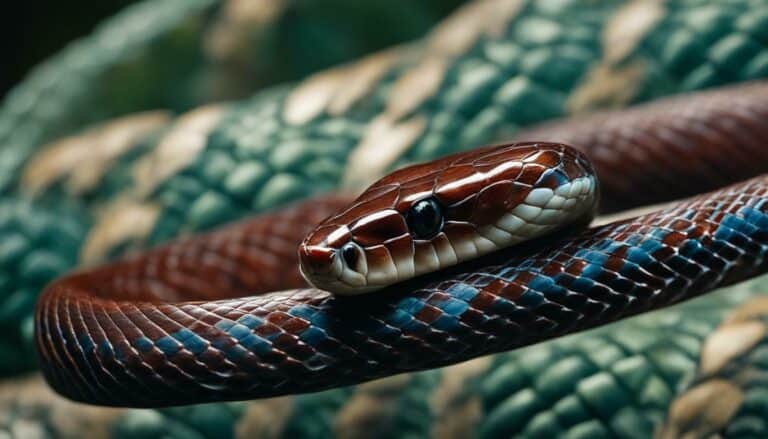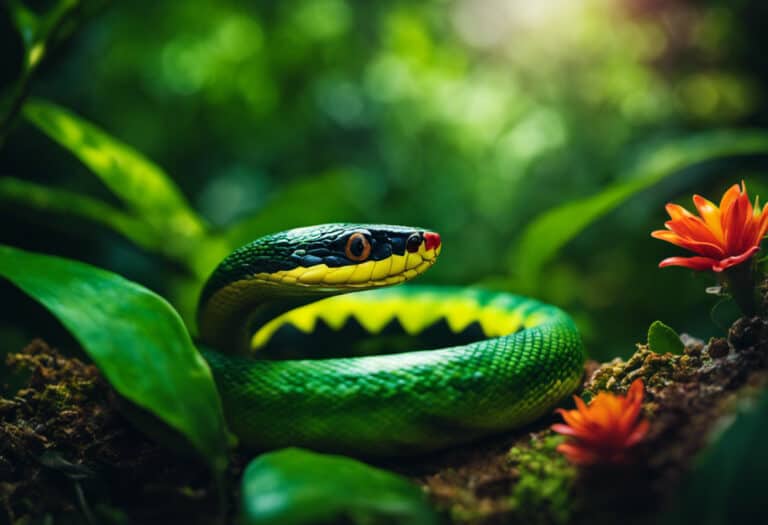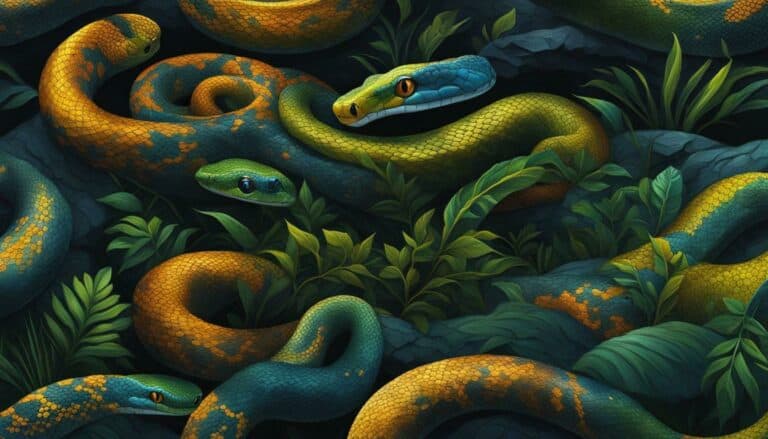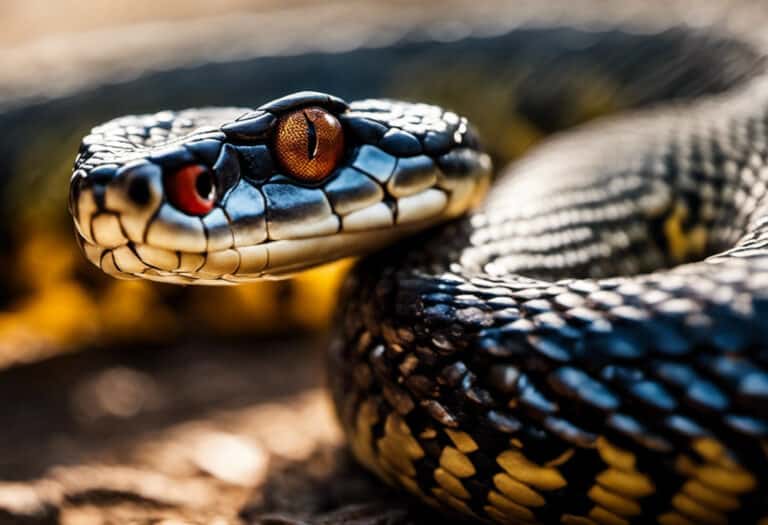Difference Between Serpent and Snake?
Are you puzzled by the distinction between serpents and snakes? Do you often mix up these terms? Well, fear not!
This article will unravel the enigma for you. We’ll delve into the subtle differences between serpents and snakes, exploring their unique traits and symbolism.
From their size and physical characteristics to their cultural significance, we’ll leave no stone unturned.
So, join us on this enlightening journey and gain a deeper understanding of these captivating creatures.
Key Takeaways
- Snakes and serpents are both terms used interchangeably for a carnivorous reptile called Serpentes.
- Serpents are typically larger than average snakes.
- The term snake is used for all types of snakes, regardless of their size.
- All serpents are snakes, but not all snakes are serpents.
Size and Physical Characteristics
When discussing the difference between serpents and snakes, it’s important to note that serpents are typically larger in size than average snakes.
Serpents have evolved and adapted over time to become larger and more powerful creatures. This evolution has allowed them to thrive in various environments and to become formidable predators.
In mythology, serpents are often depicted as symbols of power, wisdom, and transformation. They’re often associated with legends and folklore, appearing in stories from different cultures around the world.
Snakes, on the other hand, encompass a broader category of reptiles, including both large and small species. While snakes can also be powerful and dangerous, the term ‘serpent’ specifically refers to the larger, more majestic members of the snake family.
Symbolism and Cultural Significance
Snakes and serpents hold deep symbolism and cultural significance in various religions, mythologies, and literary works. They’re often associated with both good and evil, and are linked to fertility and a creative life force.
In ancient China, snakes were connected to life-giving rain, while rainbows, symbolizing rain and fertility, are commonly associated with snakes in Australia, India, North America, and Africa.
When comparing snakes and serpents to other reptiles, it’s important to note that all serpents are snakes, but not all snakes are serpents. Serpents are typically larger than average snakes, and the term ‘snake’ is used for all types of snakes, regardless of their size.
In mythology, serpents are often depicted as treacherous creatures, while snakes can represent both wisdom and deception.
Distinctions and Usage
You’ll find it helpful to understand the distinctions and usage between snakes and serpents.
Snakes and serpents are both terms used to describe the carnivorous reptile known as Serpentes. While the terms are often used interchangeably, there are some key differences.
Serpents are typically larger than average snakes. However, it’s important to note that all serpents are snakes, but not all snakes are serpents. The term snake is a more general term that encompasses all types of snakes, regardless of their size.
Historical depictions of snakes and serpents have often linked them to fertility and a creative life force in religion, mythology, and literature. Additionally, snakes have been associated with water and soil due to their habitat.
As for their evolutionary origins, both snakes and serpents have a long history dating back millions of years. They’ve adapted and evolved to thrive in various environments across the globe.
Understanding the distinctions and usage of snakes and serpents can provide valuable insight into their symbolism and cultural significance.
Cobra: A Snake or Serpent
To clarify, a cobra can be considered both a snake and a serpent due to its size.
The cobra, scientifically known as Naja, is a large and highly venomous species of snake. It falls under the category of serpents because of its size, but it’s also commonly referred to as a snake.
Cobras hold significant symbolism in various cultures and mythologies. They’re often associated with fertility and a creative life force. In many religions and ancient beliefs, cobras are seen as symbols of rain and the life-giving properties it brings.
However, it’s important to note that cobras are also dangerous predators. With their venomous bite and ability to deliver deadly strikes, they command respect and caution.
The cobra’s dual nature as a symbol of fertility and a dangerous predator showcases the complexity and intrigue surrounding this remarkable creature.
Dragons Vs. Serpents: Key Differences
Dragons and serpents have distinct characteristics that set them apart from each other. In cultural representations, dragons are often depicted as formidable creatures with wings, barbed tails, and the ability to breathe fire. They’re seen as giant reptilian beasts, associated with power and strength.
On the other hand, serpents are used to indicate large snakes. They’re typically larger than average snakes and can be associated with both good and evil in different cultures.
Serpents hold symbolic meanings in various religions, mythologies, and literature, often representing fertility and a creative life force.
In ancient China, snakes were connected to life-giving rain, while in Australia, India, North America, and Africa, rainbows, symbolizing rain and fertility, are commonly associated with snakes.
Understanding the cultural representations and symbolism of dragons and serpents helps us appreciate the differences between these two fascinating creatures.
Frequently Asked Questions
How Do Snakes and Serpents Differ in Size and Physical Characteristics?
Snakes and serpents differ in size and physical characteristics. Serpents are typically larger than average snakes. Physical features vary, but both have long, tapering bodies and are limbless.
What Are the Various Symbolic and Cultural Significances of Snakes and Serpents?
Snakes and serpents hold profound symbolic and cultural significance in various cultures worldwide. They play significant roles in mythology and folklore, representing fertility, life force, and even treachery. Their symbolism varies across different cultures and religions.
How Can One Distinguish Between the Usage of the Terms Snake and Serpent?
To distinguish between snake and serpent, focus on their distinguishing characteristics. Snake is a more commonly used term, while serpent has its etymology origins in formal writing and descriptions. Both refer to reptiles.
Is a Cobra Considered a Snake or a Serpent?
A cobra is both a snake and a serpent. It is venomous and can be considered a treacherous serpent. Snakes and serpents differ in behavior, with serpents typically being larger. Remember, a cobra is both!
What Are the Key Differences Between Dragons and Serpents?
Dragons and serpents in mythology have distinct differences. Dragons are depicted with wings and fire-breathing abilities, while serpents are large snakes. In real life, creatures like anacondas and pythons resemble serpents and snakes.
Conclusion
In conclusion, understanding the difference between serpents and snakes is important in order to accurately describe and interpret these fascinating creatures. While all serpents are snakes, not all snakes are considered serpents due to their size.
Symbolically, both snakes and serpents hold significant meanings in various cultures and mythologies, representing both good and evil, fertility, and creative life forces.
By exploring these distinctions and cultural associations, we gain a deeper understanding of the unique traits and symbolism of serpents and snakes, enhancing our appreciation for these captivating reptiles.






